Introduction:
After the first messages
were transmitted over the Atlantic Cable in August 1858 between
Valentia, Ireland, and Trinity Bay, Newfoundland, September 1st
was declared as the official day of celebration in New York City.
Unofficial celebrations had been held in New York and around the country on August 18th, following the successful transmission of messages between the Queen and the President, and on August 20th an announcement of the official date was made in the New-York Daily Tribune. Similar stories appeared in other newspapers nationwide:
INTERNATIONAL CABLE JUBILEE.
By common consent there will be a great international cable jubilee, on the 1st and 2nd of September,
throughout the United States, the Canadas, and Great Britain. Boston, Montreal, Buffalo, Chicago, St.
Louis, St. John's, New Orleans, London, and in fact
most of the leading cities of this country and England,
have signified their desire for such a demonstration,
and arrangements are in progress to carry it into effect.
The great cable jubilee in New York City is documented below, and of the many celebrations in other cities in New York State on September 1st, those in Clyde and Albany are documented elsewhere on the Atlantic Cable website.
|
The cable celebrations in New York actually started two weeks before the official date, shortly after the arrival of the USS Niagara at the Brooklyn Navy Yard following the successful conclusion of the cable expedition. On August 17th, as a prelude to the main
event:
“the
City Hall and the public buildings of New York were brilliantly
illuminated, and a magnificent display of fireworks, presented by
Mr. J. Edge, Jr., was exhibited in front of the City Hall on the
evening of the 17th August.
“It was the subject of much regret that, early on the ensuing
morning, the
dome of the City Hall was consumed by fire, doubtless, by sparks
from the fireworks having entered under some defect in the metal
covering of the roof.”
Writing on the following
day, 18th August 1858, a visitor to New York noted in a letter to
his uncle:
“We
have been having a great time here, celebrating the success
of the Atlantic Cable, cannon, flags, shouts, extra-papers,
& extra-policemen, fireworks, crowds, processions, music,
illuminations, transparencies, &c., &c., and ended by
nearly burning down the City Hall, in our delight, it having
caught from the fireworks, and lost its cupola, and part of
its upper story.”
The USS Niagara itself was a great attraction. The New-York Daily Tribune, in its issue of 20 August 1858, had this report:
THE NIAGARA AT THE NAVY YARD.
The Niagara was visited yesterday by throngs of
people, men, women and children. Row-boats were
constantly plying between the Brooklyn wharves and
the frigate, their owners making the most of and by
the occasion. The gangway was uncomfortably crowded
with visitors coming and going. From the forecastle
or quarter-deck the vessel looked like the principal
thoroughfare of a well-peopled city, where sailors, soldiers and civilians are constantly passing and repassing.
Among the visitors was Gov. King, to whom Capt.
Hudson showed the ship and explained the paying-out
machinery in detail. The Governor shook hands with
the officers on board with great heartiness, and congratulated them upon their participation in the enterprise, so successfully brought to completion. Everything on board the Niagara remains as it was when she
dropped her end of the cable in Trinity Bay—the unused coils where they were, and the wheels and the
brakes. No person should neglect to avail himself of
the present opportunity to see how the cable was laid,
as well as to examine the fine frigate which assisted
in laying it.
On September 1st, the day began with services at Trinity Church, which was filled
to overflowing. At noon Cyrus Field and the ships’ officers landed
at Castle Garden and received a national salute. A procession formed
and extended from the Battery to the Crystal Palace at 5th Avenue
and 42nd Street, where many addresses were made.
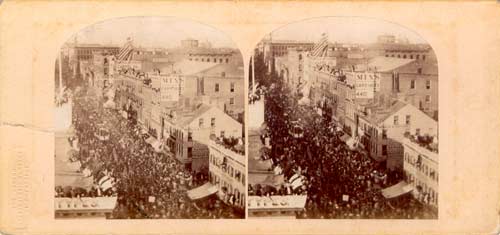
The Atlantic Telegraph Jubilee, New York.
View of the Procession in its progress up Broadway’
Photograph by William England,
sold by the London Stereoscopic Co.
Detail of stereoview.
Stereoview images courtesy of and copyright © 2007
Page and Bryan Ginns, www.stereographica.com |
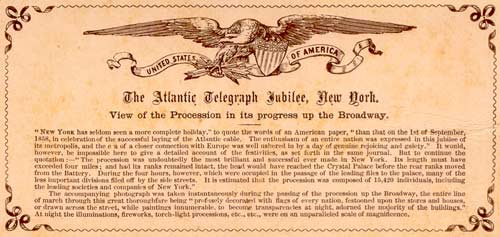
“NEW YORK has seldom seen a more complete holiday,” to quote the words of an American paper, “than that on the 1st of September, 1858, in celebration of the successful laying of the Atlantic cable. The enthusiasm of an entire nation was expressed in this jubilee of its metropolis, and the era of a closer connection with Europe was well ushered in by a day of genuine rejoicing and gaiety.”
It would, however, be impossible here to give a detailed account of the festivities, as set forth in the same journal. But to continue the quotation:—"The procession was undoubtedly the most brilliant and successful ever made in New York. Its length must have exceeded four miles; and had its ranks remained intact, the head would have reached the Crystal Palace before the rear ranks moved from the Battery. During the four hours, however, which were occupied in the passage of the leading files to the palace, many of the less important divisions filed off by the side streets. It is estimated that the procession was composed of 15,420 individuals, including the leading societies and companies of New York.”
The accompanying photograph was taken instantaneously during the passing of the procession up the Broadway, the entire line of march through this great thoroughfare being “profusely decorated with flags of every nation, festooned upon the stores and houses, or drawn across the street, while paintings innumerable. to become transparencies at night, adorned the majority of the buildings,” At night the illuminations, fireworks, torch-light processions, etc., etc., were on an unparalleled scale of magnificence. |
The daytime festivities were followed
by a firemen’s torchlight parade and fireworks displays:
“The
firemen’s torch-light parade concluded the day’s festivities. It
was exceedingly beautiful, and as the long line moved through Broadway
surrounded by an enthusiastic crowd on every side, and lighted by
thousands of torches, candles, and colored lanterns, one might easily
have imagined himself in a fairyland. It was long after midnight
before the great assemblage dispersed, and even then the streets
did not resume their wonted aspect. . . . The fact is, that an avalanche
of people descended upon us, and New York was crushed for once;
but we do not lay Atlantic cables every day”.
The Special Committee appointed
for the purpose of making suitable arrangements for the celebration
incident to the laying of the Atlantic Telegraph Cable made its
report in 1859, but the report was not published until 1863 as: Detailed Report of the Proceedings had in Commemoration of the
Successful Laying of the Atlantic Cable, by order of the Common
Council of the City of New York, by Charles T. McClenachan [New York 1863, Edmund Jones & Co, Corporation Printers, No.
26 John Street].
The Seal of New York City is shown on the back cover of the book. Appropriately, the sailor on the left holds a sounding line. Also note the cable in the eagle’s talons, not found on the standard version of the seal.
The Committee spent $25,000
on the event, not including the value of all the donated materials
and services.
The following lithographs
of the 1858 festivities are by Sarony, Major & Knapp, 449 Broadway,
N.Y., and were published in the 1861 edition of the Manual of
the Corporation of the City of New York. [New York: D.T. Valentine,
1861]
The descriptive text for the images is taken from the Report of the Proceedings. The lithographs as published in Valentine's Manual were accompanied only by the captions shown below each image.
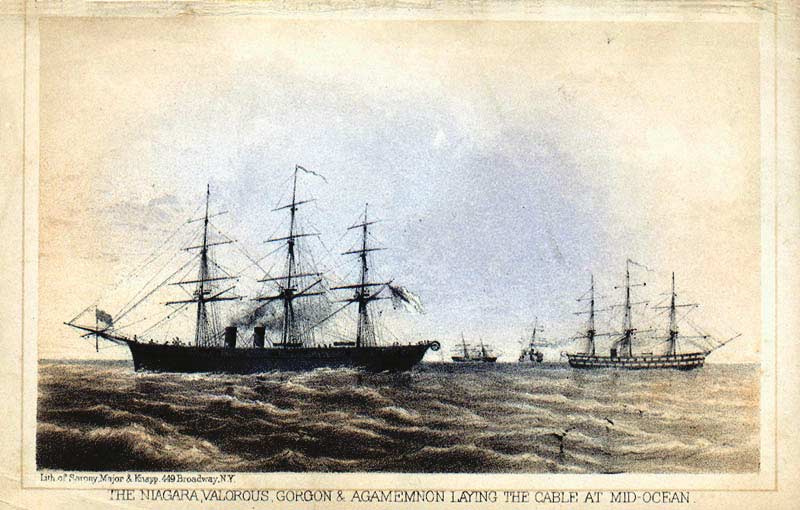
The Niagara,
Valorous,
Gorgon &
Agamemnon Laying the Cable at Mid-Ocean
“On
the 29th of July (1858) the two great ships took their places
a short distance from each other. A strong hawser fastened them
together. The end of the cable which the Niagara bore was carried
to the Agamemnon and there spliced to the end of hers; it was
then lowered into the sea, and the ships moved, each towards its
own country, at first creeping slowly till the cable had sunk
far down, and then faster, to a speed of five or six miles an
hour.”
(from David
Dudley Field’s oration at the Crystal Palace). |
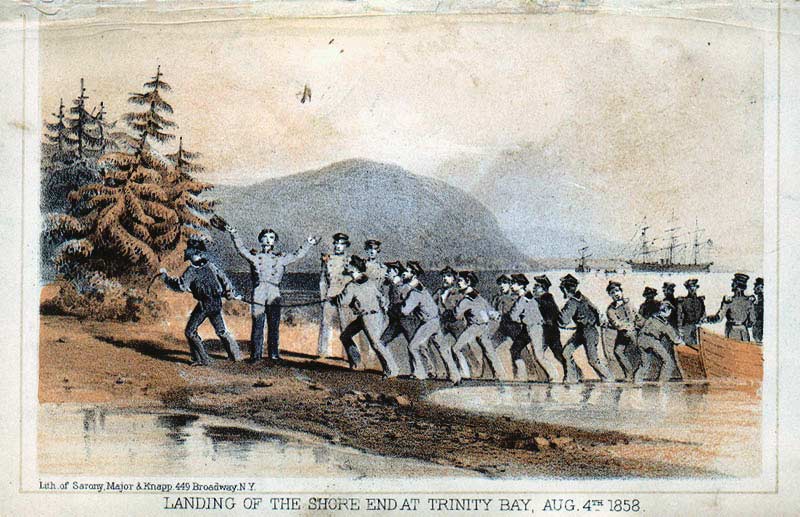
Landing of the Shore
End
at Trinity Bay, Aug 4th 1858
“At
length, on the morning of the 4th of August (1858), under as bright
a sky as ever smiled on a great achievement, the headlands of
Trinity Bay rose above the sea directly before them.
“Then there came out to meet them, and be their pilot into
their desired haven, another English ship—the Porcupine—whose
Captain, Otter, had so carefully surveyed and so closely watched,
that he had not only found all the channels, but had stationed
boats to mark the narrowest, and that the ships might be seen
far off, had sent sailors to an island of the bay, on which was
a high and wooded hill, ordering them to watch day and night,
and as soon as the fleet hove into sight to set the wood on fire.
The fire was kindled, and the burning hill was at once bonfire
and signal for the victorious ships. The bay was so deep that
the head of it was not reached till after midnight. There, at
five o’clock of the morning of the 5th of August, the end of that
mysterious wire was taken ashore; and as soon as it was secured
in its appointed station, the brave sailor and humble Christian
who commanded the Niagara, in the open air, in the early daylight,
while all the gentlemen and seamen bowed their heads reverently,
gave thanks to the Almighty for the good voyage ended.”
|
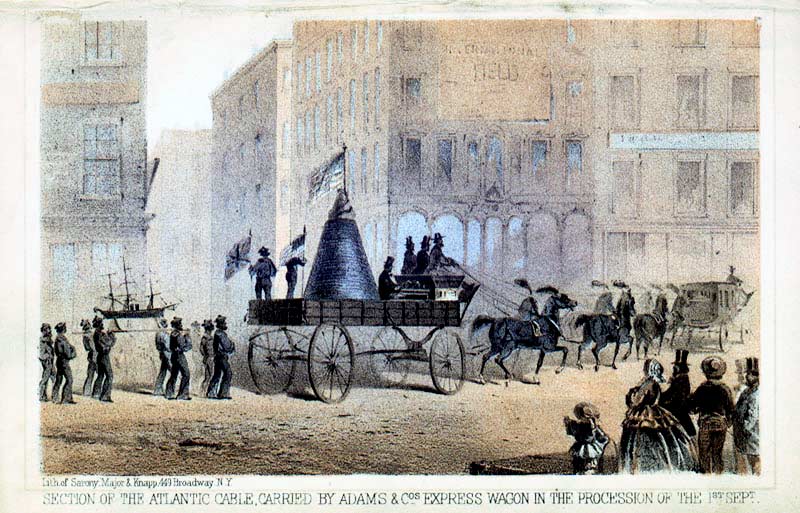
Section of the Atlantic Cable Carried
by Adams & Co’s Express Wagon
in the Procession of the 1st Sept.
Note: Sarony’s
caption for this lithograph is in error, as the Report states that:
“the
Adams’ Express Company car was drawn by twelve horses and followed
the crew of the Niagara; it carried a Hughes telegraph instrument
and a banner inscribed ‘American Telegraph Company’.”
The lithograph above actually shows the cable pyramid and six
horses of the American Express car, as described in the Report:
“The
other portion of the procession that came in for a very particular
manifestation of enthusiasm was the large coil of the Atlantic
Telegraph Cable, which was neatly wound around a pyramid on a
car drawn by six horses, gaily caparisoned with flags and plumes.
This important part of the display was confided to the care of
the brave sailors of the Niagara, and the handsome team by which
it was drawn was furnished by the American Express Company.
“Behind this car came the crew of the United States ship
Niagara, bearing before them a model of their splendid ship. These
hearty fellows were vehemently applauded.”
|
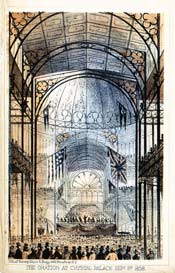
The Oration at Crystal
Palace
Sept. 1st 1858
“It
had been arranged that the procession should arrive at the Palace
at four o’clock, or as near to that hour as might be practicable.
In anticipation of this, the doors were thrown open at two, and
immediately the building began to fill. Those to whom green tickets
had been given entered by the main door, on Sixth avenue; those
who obtained white tickets were admitted through the side entrance,
on Fortieth street, and had access to the galleries in the vicinity
of the platform, which was erected in the nave, and extended backwards
from the centre to the eastern window. The platform proper occupied
but half of this space. Midway between the fountain (which is directly
beneath the dome, and but a few feet from the front of the platform,)
and the eastern end of the nave, commenced the first of a tier of
seats which, rising by regular gradations from the stand, terminated
at the farther wall and on a level with the galleries.
“The entire platform was handsomely carpeted, and both the
platform and the gallery, improvised for the orchestra, were draped
with the ‘Red, White and Blue.’ Above were suspended the English
and American colors, and from the front of the north-western gallery
depended a large green banner, bordered with golden shamrocks and
displaying in the centre an Irish harp—‘the sunburst of Erin.’
Beyond these, the Palace was destitute of any attempt at decoration.”
|
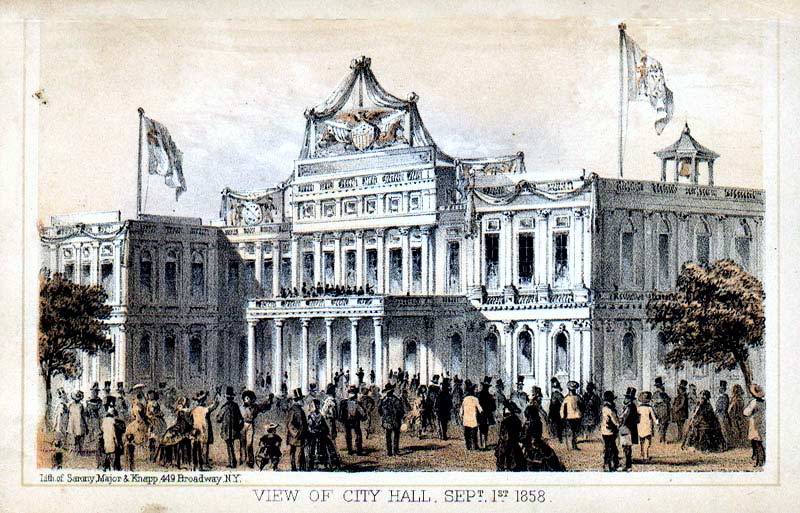
View of City Hall,
Sept. 1st 1858
“From
all the flagstaffs on the Hall gay banners and streamers were
flying. Surmounting the centre of the roof was a painting representing
the national bird with wings outspread, standing on a starred
and striped shield, as if just lighted there, with the lion and
the American standard under his right pinion, and the English
standard and unicorn under his left. Under this was the name of
FRANKLIN in large letters, one one side, the coat of arms of the
State of New York, and on the other the coat of arms of the City
of London.
“On the west side were banners with the following:
‘FIELD, WOODHOUSE, DAYMAN, COOPER, HUDSON.’
“And on the east:
‘PREEDY, GURNEY, ALDHAM, EVERETT, MORSE.’
“Facing Broadway were the following:
‘MAURY, WHITEHOUSE.’
“And facing Centre street:
‘BRIGHT, BERRYMAN.’
“The east gate of the Park, was surmounted by an immense
banner, formed like an arch, bearing on one side the words:
‘THE PATH OF FRANKLIN LED TO A FIELD OF ENTERPRISE.’
“At one end of the inscription appeared an old-fashioned
printing press, at the other, a telegraphic apparatus.
“On the other side were displayed the words:
‘PEACE HATH HER VICTORIES
NOT LESS RENOWNED THAN WAR.’
“Similar arches were erected at the western and southern
gates.”
|
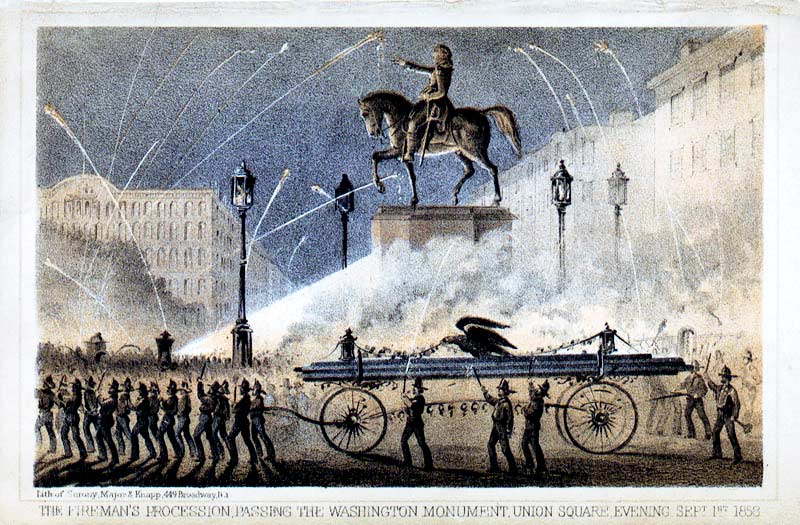
The Fireman’s Procession
Passing
the Washington Monument, Union
Square, Evening Sept 1st 1858
“At
10 o’clock the head of the procession started.
Down Forty-second street to Sixth avenue they marched, receiving
the city authorities and their guests, who accompanied the procession
in carriages. Thence, headed by deputations of policemen from the
Tenth and Thirteenth Precincts, commanded by Sergeant Waterbury,
they marched down Sixth avenue, then down Broadway; from Broadway,
at Union Square, they made a detour, and marched round the equestrian
statue of Washington, then returned to Broadway, down which they
marched to the City Hall park, and passed through the eastern entrance.
At one o’clock they were dismissed. The passage of the procession
through Broadway was a scene of unrivaled splendor. The sidewalks
were crowded with the populace. The balconies, the windows, the
house-tops, were filled with people. Almost every house was illuminated,
and the decorations that we have already described as being visible
during the day, shone with heightened effect and redoubled lustre.
The street was clear as noonday, and while the brilliant pageant
was passing, afforded a spectacle of popular rejoicing such as has
been rarely, if ever, witnessed on this continent.”
|
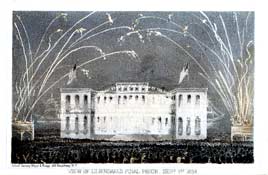
View of Liliendahl’s
Final Piece,
Sept. 1st 1858
Note: The Report spells this pyrotechnician’s name variously as Gust. A “Lillienthal” and “Lilliendahl” .
“All
the day, from the moment the sun marked early breakfast-time until
he set in a cloudless West, workmen were putting up curious sticks
and odd cross-bars along the front of the dilapidated City Hall.
These sticks and bars were the foundations of a cable and two
ships, with all the accompaniments necessary to give the telegraph
a fiery salute. At nightfall the work was finished, or rather
so far finished that it was ready to be begun when eight o’clock
came.
“The emblematic piece, which ended the show, was magnificent.
It was an allegorical representation, founded on the Cable—giving
thanks for the Cable—illustrating and illuminating the Cable.
The piece occupied the entire front of the City Hall—wings and
all. Its total length was one hundred and eighty feet. At either
end was a full rigged ship, one the Niagara, the other the Agamemnon.
Each vessel was twenty feet from stem to stern; and the height
the same up to the peak of the mainmast. An entablature, one hundred
and twenty feet long, stretched along the front of the Hall, from
wing to wing. This entablature was supported by six pillars, twenty
feet in height. Three of these pillars were on either side of
a rotating Maltese cross. Along the face of the structure ran,
in letters of fire, this inscription:
‘THE LAST NAVAL ENGAGEMENT BETWEEN COLUMBIA AND BRITANNIA—A
TIE.’
“Over this was old Father Neptune, reclining in his shell
in mid-ocean, his trident over his shoulder, and one hand uplifted,
holding a lighted cord—the Cable. The Cable ran east to “our
Eagle,” went west to “their Lion”—a surly fellow,
with his paw, holding fast his end of the cord. Behind the eagle
stood a herald, trumpeting fame; behind the lion stood another
herald, trumpeting more fame. Over all this show sprung an arch,
bearing, in letters of gold, these words:
‘GOD HAD BEEN WITH US: TO HIM BE ALL THE GLORY’
“The Cable springing from mid-ocean, the ships that payed
out the Cable, the pious telegraph sent over the wires to announce
the great result, the double-barreled pun in the first inscription,
the grand demonstration that wound up the whole—elicited continuous
shouts of approbation. The entire populace—and how many tens
of thousands there were packed into the park, we don’t like to
venture to peril our veracity by saying—gave a universal verdict
on this occasion, that the Cable was a great event.”
|
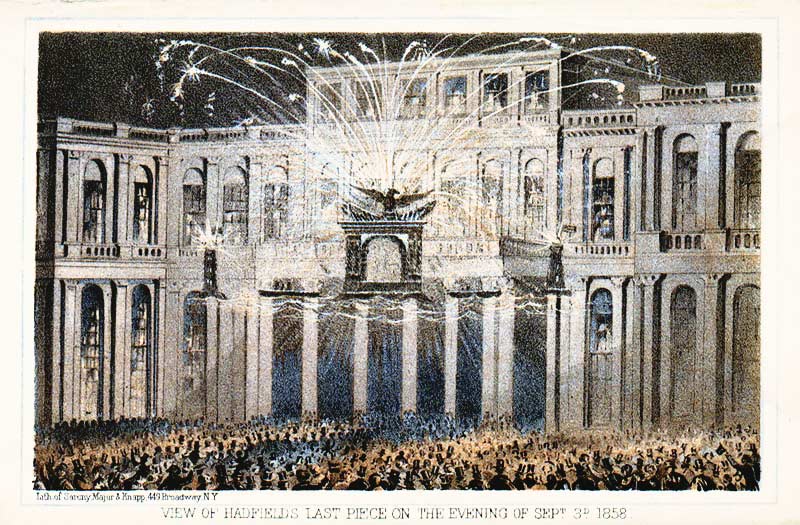
View of Hadfield’s
Last Piece
on the Evening of Sept 3d 1858
Note:
The Report records this banquet and fireworks display as
taking place on Thursday September 2nd, 1858, not September 3rd
as Sarony has it.
“Whilst
the guests at the dinner table were indulging in the multifarious
luxuries which the larder of the ‘Metropolitan’ affords, the populace
were feasting their eyes on a display of fireworks at the City
Hall. This exhibition was prepared under the superintendence,
and at the cost, of Mr. John W. Hadfield, and was witnessed by
an immense throng which crowded the park, and every place adjoining,
from which anything of the exhibition could be seen.”
Note: Mr.
Hadfield presented 21 events on his fireworks program. Here’s
the description of the finale, illustrated above:
“Grand
finale. The laying of the Atlantic Cable. In this piece some new
principles were attempted for the first time in the pyrotechnic
art; the open portion representing the Niagara and the Agamemnon
in the centre, with the tenders Gorgon and Valorous ahead; on
the extreme ends of the piece were two light houses connected
by a line of rolling waters, on which the ships slowly moved towards
their destination; on arriving at which the centre was suddenly
transformed into a magnificent temple of science, in all the splendor
of the dazzling colors, assisted by all the mechanical contrivances
of which the art is capable. Canopied by an arc of stars which
rested on revolving columns, upon whose base were recorded the
names of Franklin, Morse and Field, appeared a group of figures
representing Science uniting Columbia and Britannia. Over these
was an entablature with the motto: ‘The electric flash shall belt
the earth.’ The crowning portion showed the American coat of arms,
in which was entwined the Union Jack with the Stars and Stripes.
“In order to do honor more fully to this great success of
science over time and space, it was found desirable to employ
electricity, thus creating an actual as well as an imaginary current
through the entire length of the piece.
“The whole concluded with batteries of candles, flights of
rockets and bomb shells, filling the air to a great distance with
colored stars, gold rain, fiery meteors, serpents, &c.
“And so, in the City of New York, were terminated the public
rejoicings in honor of the successful submersion of the Transatlantic
Cable.”
|
Napoleon Sarony,
Lithographer and Photographer
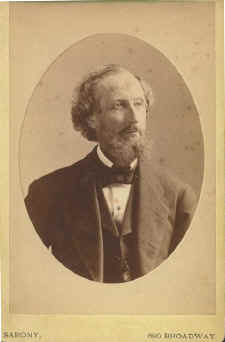
CDV of Cyrus Field,
photographed
by Sarony, 680 Broadway. |
Napoleon
Sarony was born in Quebec in 1821. He moved to New York around
1836 and studied with Archibald Robinson. He worked for Nathaniel
Currier before starting a business with James P. Major in 1843.
In 1845 James Major was replaced by Henry B. Major in Sarony &
Major. Sarony’s next corporate incarnation was known as Sarony,
Major & Knapp in which he was joined by Richard Major and
Joseph F. Knapp from 1857 to 1867. He withdrew from the firm around
1867 to establish a studio of photography. Sarony later spent
six years in Europe, where he visited lithographers in Berlin
and Paris. He eventually returned to New York and set up another
photographic studio. He died in 1896.
Information on Sarony from University of Pennsylvania: Annenberg Rare Book & Manuscript Library |
The Illustrated
London News had its own account of the events:
FETES
AT NEW YORK TO COMMEMORATE THE LAYING
OF THE ATLANTIC TELEGRAPH CABLE.
[September 25, 1858.]
Of
the fete at New York on the 17th inst., we have the following particulars
from the gentleman who supplied us with the sketch of the City Hall
as it was illuminated on the night of the 17th, and which is engraved
here:-
The
publication of her Majesty’s message to the President of the United
States on the morning of August 17, carrying with it, as it did,
the assurance that the telegraphic wires were really capable of
transmitting despatches, caused an outburst of enthusiasm in the
Atlantic States which might almost be characterised by the American
qualificative “universal.” Wherever the news penetrated
there was a public jubilee. In Boston, Portland, Philadelphia, Baltimore,
and other places, bells were rung, salutes fired, illuminations
spontaneously undertaken; but in New York the most thorough and
systematic display of popular joy took place. A little after daybreak
on the morning of the 17th the celebration was commenced by the
discharge of cannon in the park; and as the sun rose above the heights
of Long Island his rays fell upon an assemblage of cities—New
York, Brooklyn, Jersey City, Hoboken, Williamsburgh,—decked in
flags and resounding with the merry peal of a thousand bells. But
the principal feature of the celebration was the illumination of
the city at night, together with the display of fireworks provided
by the municipality. Not only that unparallelled thoroughfare, Broadway,
was illuminated and decorated for two or three miles of its length,
but the lesser streets were also brilliant in many-coloured fires.
Wall-street—the centre of American commerce and finance—glittered
strangely under the quiet sky. Nassau-street, crowded with newspaper-offices,
was a thoroughfare of light. Bonfires blazed in every direction.
Transparencies were displayed upon every hotel and many private
dwellings. Epigrammatic and laudatory mottoes glowed upon the fronts
of granite and marble stores. The City Hall, which stretches its
white façade half across the narrow, triangular park, was lit up
as never before; every pane in its innumerable windows bore a light.
The watcher in the illuminated clock-tower looked down (for the
last time, as it proved) on a throng such as the park, used as it
is to vast assemblages, has never before contained. The heavy foliage
of the lime and elm trees with which it is studded was scarcely
denser than the crowd assembled in expectation of the pyrotechnic
display. The night was moonless, and a cloudy sky favoured the occasion,
so that by eight o’clock the signal rockets were sent up, accompanied
by fire-balloons. Streams of fiery particles and globules of variegated
flame shot up far into the heavens, as if to announce to the lightning
its final triumph in submission. Roman candles rose and fell in
perpetual ebullition; erratic rockets hissed and surged upwards
in contending streams; serpents, cometlike, darted through the air;
and at length the great flame-structures erected upon the wings
of the City Hall were fired. The illumination paled before their
rippling lustre; and cheer after cheer arose from the immense assemblage
as the designs became developed in succession. Among the most elaborate
pieces was one representing a British and an American vessel, with
the union-jack and the stars and stripes at each side, surmounted
by the inscription-"All Honour to Cyrus W. Field! Franklin,
Morse, and Field.” (Mr. Field is a gentleman, a resident of
New York, who has been very active in the telegraphic enterprise,
and Professor Morse was one of the first to elaborate the idea of
electro-telegraphic communication.) Other pyrotechnics presented
similar devices and allusions, during the continuance of which the
National Anthem of Great Britain, together with ‘Hail Columbia!” and “St. Patrick’s Day,’ was played by an attendant band. With
a further discharge of rockets the display was concluded, and by
half-past nine the spectators had dispersed.
It
unfortunately happened that some sparks fell upon the woodwork of
the clock-tower of the City Hall, and flames burst out there about
midnight, which finally consumed the tower, and largely damaged
the building itself. As the central fire-alarm was located on this
spot, the intelligence could not be communicated instantly, as usual,
to the engine-houses, and the delay which ensued proved fatal to
the structure. The scene, however, was magnificent. The statue of
Justice, a familiar sight to all New Yorkers, stood wrapt for a
length of time in the flames of the grand illumination, and serenely
endured the fiery glow for more than an hour, until at length she
was observed to totter and fall into the flames. Many valuable paintings,
and some relics of General Washington, were injured by the water;
but the city and judicial records were, fortunately, not endangered.
Fifty thousand dollars are required to repair the injury caused
by this disaster.

The 1858 cable |
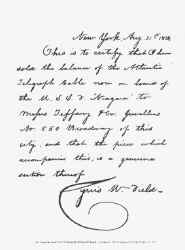
Letter of authentication
for the Tiffany cable samples, signed by Cyrus Field |

Souvenir cable piece
sold by Tiffany & Co. |
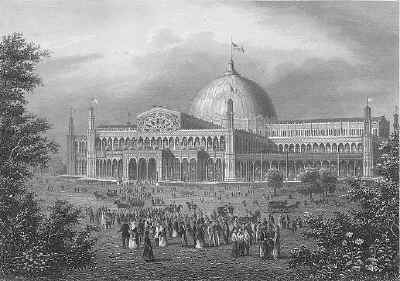
The Crystal Palace in Reservoir Square, New York
(now the site of Bryant Park and the New York Public Library).
The Crystal Palace was opened on July
24, 1853, and
destroyed by fire
on October 5th, 1858,
shortly
after its use for the Atlantic Cable
celebration. |

New York Crystal Palace, Frontispiece to New York Crystal Palace: illustrated description of the building by Geo. Carstensen & Chs. Gildemeister, architects of the building ; with an oil-color exterior view, and six large plates containing plans, elevations, sections, and details, from the working drawings of the architects (New York: Riker, Thorne & co., 1854) |
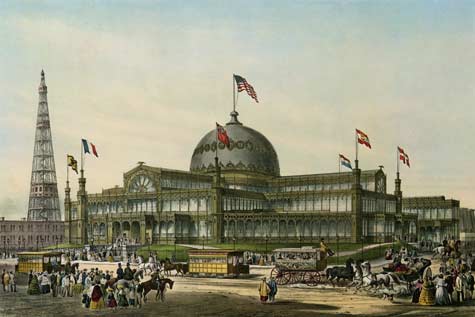
Another view of the Crystal Palace, from an 1853 N. Currier print |
Return to the Atlantic Cables index page |

